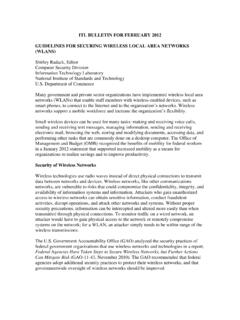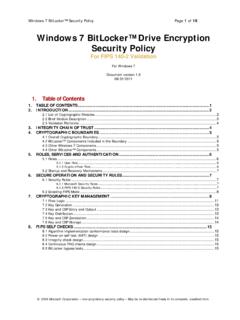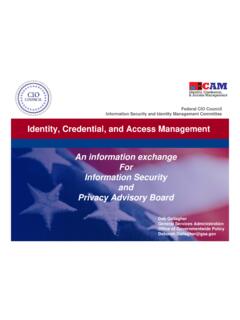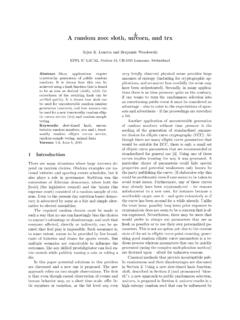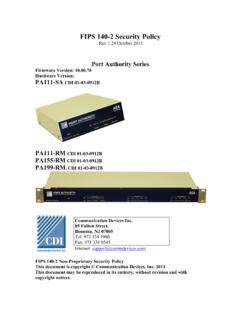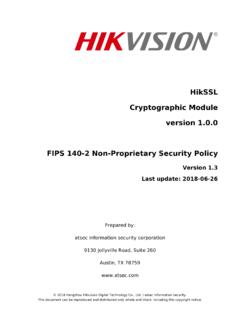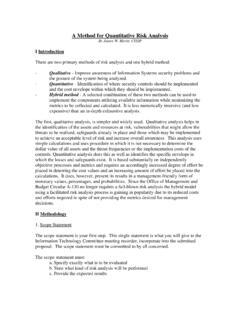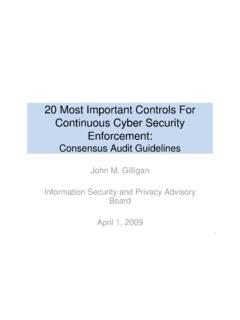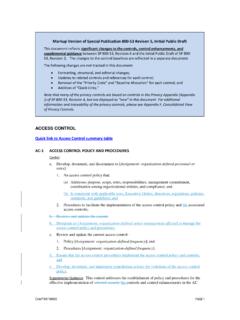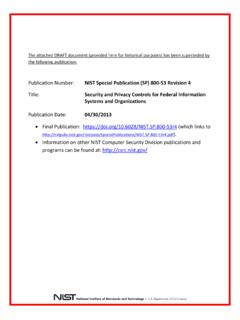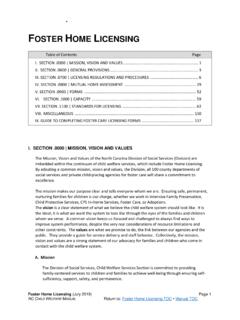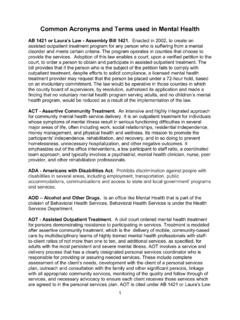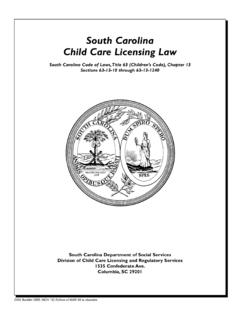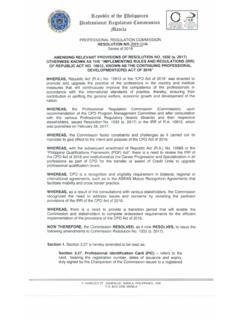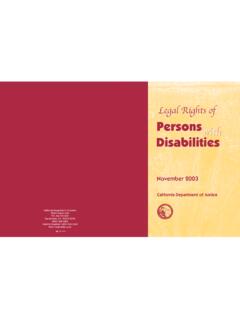Transcription of SECURITY REQUIREMENTS FOR CRYPTOGRAPHIC MODULES - …
1 FIPS PUB 140-2 CHANGE NOTICES (12-03-2002) FEDERAL INFORMATION PROCESSING STANDARDS PUBLICATION (Supercedes FIPS PUB 140-1, 1994 January 11) SECURITY REQUIREMENTS FOR CRYPTOGRAPHIC MODULES CATEGORY: COMPUTER SECURITY SUBCATEGORY: CRYPTOGRAPHY Information Technology Laboratory National Institute of Standards and Technology Gaithersburg, MD 20899-8900 Issued May 25, 2001 Department of Commerce Donald L. Evans, Secretary Technology Administration Phillip J. Bond, Under Secretary for Technology National Institute of Standards and Technology Arden L. Bement, Jr., Director i Foreword The Federal Information Processing Standards Publication Series of the National Institute of Standards and Technology (NIST) is the official series of publications relating to standards and guidelines adopted and promulgated under the provisions of Section 5131 of the Information Technology Management Reform Act of 1996 (Public Law 104-106) and the Computer SECURITY Act of 1987 (Public Law 100-235).
2 These mandates have given the Secretary of Commerce and NIST important responsibilities for improving the utilization and management of computer and related telecommunications systems in the Federal government. The NIST, through its Information Technology Laboratory, provides leadership, technical guidance, and coordination of government efforts in the development of standards and guidelines in these areas. Comments concerning Federal Information Processing Standards Publications are welcomed and should be addressed to the Director, Information Technology Laboratory, National Institute of Standards and Technology, 100 Bureau Drive, Stop 8900, Gaithersburg, MD 20899-8900. William Mehuron, Director Information Technology Laboratory Abstract The selective application of technological and related procedural safeguards is an important responsibility of every Federal organization in providing adequate SECURITY in its computer and telecommunication systems.
3 This publication provides a standard that will be used by Federal organizations when these organizations specify that CRYPTOGRAPHIC -based SECURITY systems are to be used to provide protection for sensitive or valuable data. Protection of a CRYPTOGRAPHIC module within a SECURITY system is necessary to maintain the confidentiality and integrity of the information protected by the module. This standard specifies the SECURITY REQUIREMENTS that will be satisfied by a CRYPTOGRAPHIC module. The standard provides four increasing, qualitative levels of SECURITY intended to cover a wide range of potential applications and environments. The SECURITY REQUIREMENTS cover areas related to the secure design and implementation of a CRYPTOGRAPHIC module.
4 These areas include CRYPTOGRAPHIC module specification; CRYPTOGRAPHIC module ports and interfaces; roles, services, and authentication; finite state model; physical SECURITY ; operational environment; CRYPTOGRAPHIC key management; electromagnetic interference/electromagnetic compatibility (EMI/EMC); self-tests; design assurance; and mitigation of other attacks. Key words: computer SECURITY , telecommunication SECURITY , cryptography, CRYPTOGRAPHIC MODULES , Federal Information Processing Standard (FIPS). National Institute of Standards Government Printing Office For Sale by the National and Technology Washington: 2001 Technical Information FIPS PUB 140-2 Service 64 pages (May 25, 2001) Department of Commerce ii Federal Information Processing Standards Publication 140-2 May 25, 2001 Announcing the Standard for SECURITY REQUIREMENTS FOR CRYPTOGRAPHIC MODULES Federal Information Processing Standards Publications (FIPS PUBS) are issued by the National Institute of Standards and Technology (NIST) after approval by the Secretary of Commerce pursuant to Section 5131 of the Information Technology Management Reform Act of 1996 (Public Law 104-106) and the Computer SECURITY Act of 1987 (Public Law 100-235).
5 1. Name of Standard. SECURITY REQUIREMENTS for CRYPTOGRAPHIC MODULES (FIPS PUB 140-2). 2. Category of Standard. Computer SECURITY Standard, Cryptography. 3. Explanation. This standard specifies the SECURITY REQUIREMENTS that will be satisfied by a CRYPTOGRAPHIC module utilized within a SECURITY system protecting sensitive but unclassified information (hereafter referred to as sensitive information). The standard provides four increasing, qualitative levels of SECURITY : Level 1, Level 2, Level 3, and Level 4. These levels are intended to cover the wide range of potential applications and environments in which CRYPTOGRAPHIC MODULES may be employed. The SECURITY REQUIREMENTS cover areas related to the secure design and implementation of a CRYPTOGRAPHIC module.
6 These areas include CRYPTOGRAPHIC module specification, CRYPTOGRAPHIC module ports and interfaces; roles, services, and authentication; finite state model; physical SECURITY ; operational environment; CRYPTOGRAPHIC key management; electromagnetic interference/electromagnetic compatibility (EMI/EMC); self-tests; design assurance; and mitigation of other attacks. This standard supersedes FIPS 140-1, SECURITY REQUIREMENTS for CRYPTOGRAPHIC MODULES , in its entirety. The CRYPTOGRAPHIC Module Validation Program (CMVP) validates CRYPTOGRAPHIC MODULES to Federal Information Processing Standard (FIPS) 140-2 and other cryptography based standards. The CMVP is a joint effort between NIST and the Communications SECURITY Establishment (CSE) of the Government of Canada.
7 Products validated as conforming to FIPS 140-2 are accepted by the Federal agencies of both countries for the protection of sensitive information (United States) or Designated Information (Canada). The goal of the CMVP is to promote the use of validated CRYPTOGRAPHIC MODULES and provide Federal agencies with a SECURITY metric to use in procuring equipment containing validated CRYPTOGRAPHIC MODULES . In the CMVP, vendors of CRYPTOGRAPHIC MODULES use independent, accredited testing laboratories to have their MODULES tested. National Voluntary Laboratory Accreditation Program (NVLAP) accredited laboratories perform CRYPTOGRAPHIC module compliance/conformance testing. 4. Approving Authority.
8 Secretary of Commerce. 5. Maintenance Agency. Department of Commerce, National Institute of Standards and Technology, Information Technology Laboratory (ITL). 6. Cross Index. a. FIPS PUB 46-3, Data Encryption Standard. b. FIPS PUB 74, Guidelines for Implementing and Using the NBS Data Encryption Standard. c. FIPS PUB 81, DES Modes of Operation. d. FIPS PUB 113, Computer Data Authentication. iii e. FIPS PUB 171, Key Management Using ANSI f. FIPS PUB 180-1, Secure Hash Standard. g. FIPS PUB 186-2, Digital Signature Standard. h. Special Publication 800-2, Public Key Cryptography. i. Special Publication 800-20, Modes of Operation Validation System for the Triple Data Encryption Algorithm (TMOVS): REQUIREMENTS and Procedures These documents may be found at the CMVP URL Other NIST publications may be applicable to the implementation and use of this standard.
9 A list (NIST Publications List 91) of currently available computer SECURITY publications, including ordering information, can be obtained from NIST. 7. Applicability. This standard is applicable to all Federal agencies that use CRYPTOGRAPHIC -based SECURITY systems to protect sensitive information in computer and telecommunication systems (including voice systems) as defined in Section 5131 of the Information Technology Management Reform Act of 1996, Public Law 104-106. This standard shall be used in designing and implementing CRYPTOGRAPHIC MODULES that Federal departments and agencies operate or are operated for them under contract. CRYPTOGRAPHIC MODULES that have been approved for classified use may be used in lieu of MODULES that have been validated against this standard.
10 The adoption and use of this standard is available to private and commercial organizations. 8. Applications. CRYPTOGRAPHIC -based SECURITY systems may be utilized in various computer and telecommunication applications ( , data storage, access control and personal identification, network communications, radio, facsimile, and video) and in various environments ( , centralized computer facilities, office environments, and hostile environments). The CRYPTOGRAPHIC services ( , encryption, authentication, digital signature, and key management) provided by a CRYPTOGRAPHIC module are based on many factors that are specific to the application and environment. The SECURITY level to which a CRYPTOGRAPHIC module is validated must be chosen to provide a level of SECURITY appropriate for the SECURITY REQUIREMENTS of the application and environment in which the module will be utilized and the SECURITY services that the module will provide.
